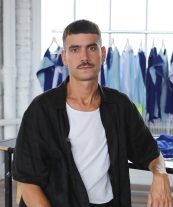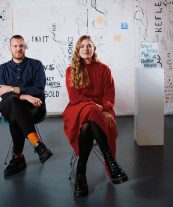COMMON GROUNDS: Gabriel Fontana x ST-DUO

 1
1
— ‘Assumptions can be the biggest wormholes’
Gabriel Fontana was nominated for the Dutch Design Award for Young Designer in 2023. In his projects, he uses sport to challenge existing social norms. Through new forms of collaboration he aims to create a more inclusive society. In this year’s DDA exhibit he shines the spotlight on ST-DUO (Sophie Balch and Tijn de Kok). Their work brings together graphic design, co-creation and campaign development, where they consistently prioritise the human element.
Gabriel: “I was very excited to select ST-DUO because their project in collaboration with Misiconi is incredibly inspiring. It challenges the long-standing norm of designing for a singular, dominant body type—often white, cis male, able-bodied, and privileged. For too long, design has catered to this narrow paradigm, neglecting those on the margins. I believe that projects like ST-DUO and Misiconi’s are crucial in shifting design concerns towards resetting priorities. Not just designing for but also with historically overlooked groups, placing them at the centre of the design process.”
Sophie: “Gabriel’s work lives at the crossroads where aesthetics meets functionality, which always fascinates us. His projects are very aesthetically pleasing yet carry an important message. Profound research always underpins his projects and they are executed to an incredibly high standard.”
State of confusion
Gabriel: “I feel we tend to oversimplify the social world and that is reflected in the way we design our environment. Society is organised according to various binary categories–male/female, black/white, able-bodied/disabled–and sectors like sports and dance follow that structure. Through my work, I aim to restore some complexity by creating these ‘in-between’ worlds, full of nuances and complexities. I use disorientation as a design strategy, making people question the space they are in, their relationships to that space and the others within it. I strive to create room for self-reflection, and promote a new way of understanding and connecting with others. As designers, our role isn’t just to ask questions but to show that alternatives are possible.”
Sophie: “Much of our work is also about instigating self-reflection. In our collaboration with the dance company Misiconi, we are designing with a mixed group of people, both with and without cognitive learning difficulties. In our research, we found that existing designs for those with learning difficulties were extremely simplified and childish in their aesthetics. Our goal was to challenge this assumption and find a way to visualise the process and maintain creativity without oversimplifying. When we start designing inclusively, we can fall into the trap of designing for a particular disability rather than considering how this process can involve everybody. We found that people with cognitive disabilities were, in a sense, freer in their learning and were able to express themselves in abstract forms. All the dancers, both with and without disabilities, enjoyed working in an abstract visual way–they said it aided them in their self-reflection. It was a powerful reminder for us: let’s not design for our differences, but for what brings us together.”
Gabriel: “When I’m designing for different types of learners, I frequently confront my own preconceptions. For instance, when I first collaborated with the schools, I assumed some aspects of my sessions or games would be too complex for the kids. But it turned out to be easier for them to grasp than for the adults. We all need to move beyond these limiting beliefs that can be deeply ingrained.”
Happiness
Tijn: “Happiness is at the heart of our approach to every project. Each journey begins with a ‘Vision Workshop,’ where we use our empathy to truly listen to and explore the client’s ideas. Together, we create a space that fully reflects their vision. We don’t start designing until they completely inhabit that universe—when they embody it and feel empowered by their own ideas. Only then do we have the perfect foundation to develop a design.”
Gabriel: “I strive to create space to foster joyful connections. Through play, participants become aware of the differences between them, which is the first step. You must first acknowledge diversity; from there you can develop empathy and offer support to one another. People’s ability to change their minds and adopt a new perspective is all about whether they feel empowered and happy to do so.”
Sophie: “Sparking positivity in the design process, by asking thoughtful questions and ensuring everyone feels heard, creates a rewarding experience for all. Together, we can find joy in the act of creation.”
Evelien Reich has served as chair of the Young Designer jury of Dutch Design Awards for the past three years. This year, she interviews the Young Designers that DDA has selected from the archives, as well as the emerging talents they choose to spotlight. All twenty Young Designers, both past and present, will showcase their work at the 2024 DDA exhibition during Dutch Design Week in Eindhoven, taking place 19 to 27 October.
Discover the work of Gabriel Fontana and ST-DUO and all the other Young Designers of the Past & Present in the DDA24 exhibition at Microlab Hall on Strijp-S, during Dutch Design Week. From 19 to 27 October 2024 in Eindhoven.